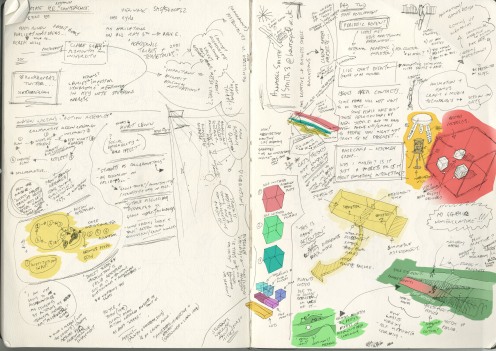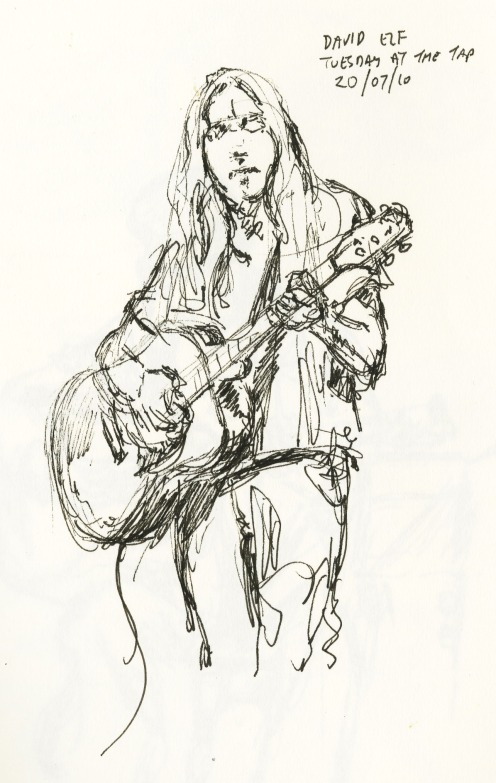Creative Tools – The Day Book/Sketchbook
The “DAY-BOOK”.
This set of notes, originally devised by myself and my teaching colleague Andy Fairbank as a handout, has been delivered in various forms to a range of students from Btec to Degree level.
The creatives notepad, journal, field book or sketchbook is something so invaluable and an integral part of the fabric of the practicing illustrator/designer/creative that it must be encouraged in students.
Our students, however, often tend to be terrified and cowed by the thought of it, believing that every mark made by their pen must have value (as they weigh it) and be part of a well-received and finished piece of work.
This of course is not true. It is just another of the varied and unhelpful myths carried amongst the debilitating baggage of the young creative.
The sketchbook is the gym for observation, a workshop for the creatives mind, space to spread out and bang nails into ideas and prize problems apart to look at their innards, and as an experimental place, some elements of it can therefore record failures.
And they should.
Failure is part of the design and personal development process.
(and to be honest, speaking as a professional, there is no safer place to fail than in a sketchbook).
With this idea of recording failure added to the fear of making marks that do not meet the high standards of the students ambition, is it any wonder that the word “sketchbook” causes the range of reactions from incredulity (“You want me to do HOW MANY thumbnail drawings?!!”) to cognitive dissonance (“Yes, well I don’t really believe in sketching, I like to do the final detailed images first”) and back again.
We can, though, remove some of that fear and perhaps encourage the utilisation of this centuries old artistic and creative tool by simply removing the terrifying word “Sketch” (this alone seems to be enough to conjure up vague traumatising imagery related to the chalk and metal point works of various Dutch and Renaissance masters that they feel they must measure themselves against).
Instead we might call it a “Day-book”, the only threat to self included in that title being the notion perhaps, that it must be used… every day.
…
Well? What is a DAY-BOOK?
For the student just starting their journey as a life long creative, these “day-books” will become (as discussed above) a cross between a “sketchbook” and a “works diary”.
Works diaries:
Many industry professionals keep to hand a notebook or diary in which to record information taken at briefing sessions, general meetings as well as from telephone conversations with clients, contractors and suppliers.
These notes, often with the date (and times) written at the top of the page at the beginning of each day, provide a clear log of events over the course of a project or working year.
This document is invaluable in the work place as it allows the review and post project dissection of events as they happened.
Sketchbooks:
The purpose of a good, working sketchbook in the traditional sense has always been to help personal development; it is not just a repository for one-off drawings or a glorified scrapbook in which to “present” your research. It’s the place where you jot down half-formed ideas, where you are freed from the constraints of “finish” and polish if you want to be… The sketchbook is just for you, and the contents for you to share with as few or as many people as you wish to.
It is kept by you, for you, and should help you to see the development of your own ideas in both written and visual form. It does not need to be organised as if it is for presentation for anyone else (if need be keep a “secret sketchbook” that you don’t show anyone until you are happier with your drawing).
…
Your “Day-book’s” will be hybrids of these two ideas…
…
…and so, what do I put in it?
A good working Day-book might/can therefore contain (but not be exclusive to):
Dated pages,
Rough drawings with annotations (remember these notes are for yourself and can be quick and even un-grammatical, but what they must be is USEFUL), this might include some honest self-evaluation,
Fragments of ideas, written notes,
Colour tests, asides, personal thoughts on your college work, and/or personal projects,
Diagrams, plans, schematic drawings with dimensions,
Experiments with marks, and mark-making.
 …and basic drawing exercises or warm-ups.
…and basic drawing exercises or warm-ups.
Notes from lectures, tutorials and workshop sessions or briefings, and any important reminders,
…the obvious content of developmental sketches,
…Annotated research,
…Collected 2D images and photocopies cut out and stuck in with your own notes as to why,
Personal statements and standpoints… and more importantly… questions!
…occasionally more polished works of art/design,
…development of ideas, plans, and information to communicate your ideas to others,
Life drawing, or drawing from life…
Other drawing from direct observation, whether capturing images of people…
…events,
or the environment…
or architecture…
…or even exploratory anatomical studies.
Quotations,
…and even shopping lists! (at least this way we will know that you have been taking your Day-books everywhere with you).
…
Remember! Your course tutors are experienced in looking for the qualities in a good working sketchbook and you should not feel under pressure to make your sketchbook pages clearer or spend time worrying over presentation issues.
Development work is done to develop ideas… save your presentation skills for your projects final presentation sheets!
Also… I can’t emphasise this enough… It is essential that use your day-book regularly, i.e. ideally every day (hence the name!) and you should strive to keep it as up to date as possible.
For example: Students often collect/produce some the materials/contents mentioned above without putting it immediately in their sketch books, leaving it for later when it often becomes a chore and difficult to annotate; the original spontaneous thoughts having “evaporated”. This invariably leads to the book lacking the sense of lively and immediate self-development.
IF YOU HAVE AN IDEA, PUT IT IN YOUR BOOK STRAIGHT AWAY… IF YOU FIND A GREAT PIECE OF REFERENCE, STICK IT IN YOUR BOOK AND RECORD WHY YOU THOUGHT IT WAS GREAT/USEFUL STRAIGHT AWAY!! if you’ve drawn an idea on a lonely scrap of paper because your sketchbook was at that exact moment out of reach… stick it into your book that night!*
*By leaving this process until later, the very process of sorting a lot of these loose materials in one session to go in the sketchbook it becomes too easy to ‘edit out’ bits that have seemed to become irrelevant. If this happens the books become less lively as the ‘bits that don’t seem to fit ‘usually create a less predictable sense of development, and you loose elements that could well prove valuable later.
REMEMBER! As a ‘visual diary’ it is also a good idea to put the date on each page as this will help you to track your own progress, particularly if like me, you don’t always progress through a book page by following page.
By following the suggestions above you will hopefully come to understand the value and importance of keeping a “Day-book”, as they will be used by you everyday for gathering research, developing ideas, recording problems and solutions, and that will act as both a personal and “professional” diary, ultimately feeding back into your main design, creative work and process… and quite probably something that you will keep for a long time after you have finished your course.
…and when it all seems too much to ask, or too difficult to maintain, I remember the image of the apartments drawn by Paul Madonna in ‘Everything Is Its Own Reward‘ next to which he wrote:
“I kept meeting people who claimed to be artists but never made anything. Always the same excuses: time, money, space. So I decided I’d use only supplies that fit in my backpack. I could draw and write anywhere, anytime, so if I didn’t, I’d be to blame.”
…
For other Day-book/Sketchbook examples and inspiration, you might want to take a look at the following books:
The Hallowed Seam/Process Recess – James Jean
Robots, Spacedudes, Flying Ships etc: A book of drawings by – Ian McQue
The Bird King, and other sketches – Shaun Tan
An Illustrated Life: Drawing Inspiration from the Private Sketchbooks of Artists, Illustrators and Designers – Danny Gregory
All Over Coffee & Everything Is Its Own Reward – Paul Madonna
Paris Sketchbook – Fabrice Moireau
The Art of Urban Sketching: Drawing On Location Around The World – Gabriel Campanario
and this…
Moonshine: Artists After Dark – Various
…
…so, off you go, and try to enjoy the process.





































[…] conceptualise the various elements needed to flesh out your chosen “environment” using your “day books”, and other appropriate digital and traditional development media including your […]
3D Design/Exhibitions/Events brief – “Environment” | apophenia inc. said this on January 21, 2014 at 4:14 pm |
Hi Dave, this is not an not an official brief per se, but if you fancy having a go and it doesn’t impact on your other work I don’t see why it couldn’t be a good portfolio builder/side project. There are clearly opportunities for development of concept art skills and perspective drawing, schematics etc.
Keep an eye out however as I’ll be posting another three in this style.
[…] will be asked to research such events and productions making notes in your “day books” and blogs and other appropriate media including your thoughts on the various creative roles and […]
3D Design/Exhibitions/Events brief 002 – “Event” | apophenia inc. said this on January 22, 2014 at 12:49 pm |
[…] need to record all your findings, considerations, discussion outcomes and initial ideas via your “day books”, blogs and other recording […]
3D Design/Exhibitions/Events brief 003 – “Public Space” | apophenia inc. said this on January 22, 2014 at 3:53 pm |
[…] will be asked to research and make notes in your “day books” on the various creative roles and tasks that might be engaged or take place in such an […]
3D Design/Exhibitions/Events brief 004 – “Adaptation” (open outcome version). | apophenia inc. said this on January 22, 2014 at 6:12 pm |
[…] the principles of Drawing in Perspective. Make notes on your blog, via your sketchbooks/daybooks (scans) if […]
Interior/Exterior – Environment Drawing Mini-Brief. | apophenia inc. said this on March 20, 2014 at 7:08 pm |
[…] sketches/and final design image produced in your sketchbook/daybook and developed into conventional presentation […]
Mini Brief (AP)12 – Appeal pt1 | hesiranimation said this on May 1, 2014 at 1:49 pm |
[…] The Creative Sketchbook or “Day Book” […]
Drawing & Traditional Rendering 2 – inc “Pareidolia” (Work in Progress). | apophenia inc. said this on October 2, 2014 at 4:29 pm |
[…] get up and get outside (or simply take a closer look at the building you are already in). USE YOUR DAY-BOOKS, make notes on how the light glints off that modern structure, get a thumbnail sketch showing the […]
Environment Design For Games – Early considerations & Ideation | apophenia inc. said this on October 19, 2016 at 7:56 am |